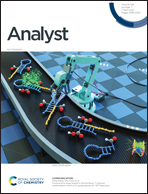Using amyloid autofluorescence as a biomarker for lysozyme aggregation inhibition†
Abstract
The assembly of proteins into amyloidogenic aggregates underlies the onset and symptoms of several pathologies, including Alzheimer's disease, Parkinson's disease and type II diabetes. Among the efforts for fighting these diseases, there is a great demand for developing novel, fast and reliable methods for in vitro screening of new drugs that may suppress or reverse amyloidogenesis. Recent studies unravelled a progressive increase in a blue autofluorescence upon amyloid formation originated from many different proteins, including the peptide amyloid-β, lysozyme or insulin. Herein, we propose a drug screening method using this property, avoiding the use of external probe dyes. We demonstrate that the inhibition of lysozyme amyloid formation by means of two known inhibitors, tartrazine and amaranth, can be monitored based on the autofluorescence of lysozyme amyloid aggregates. Our results show that amyloid luminescence is an intrinsic property that can be potentially applied in a screening assay, allowing the ranking of drug efficiency. The assays demonstrated here are fast to perform and suitable for scaling using microplate assays, configuring a new sensitive and economically feasible method.



 Please wait while we load your content...
Please wait while we load your content...